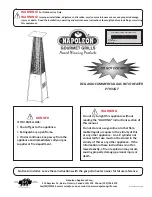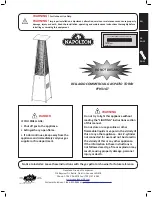
10
Chapter 4 |
Connection and start-up
BA-ST 9022-9100-FE
• Check the operation of the safety valve as de-
scribed by the manufacturer of the valve.
• Clean the inside of the storage tank periodically.
Cleaning intervals depends, among other things,
on the hardness of the water present in a given
area.
• To ensure optimum protection of the storage tank
against corrosion, we recommended checking
the level of wear of the isolated magnesium an-
ode once a year.
• The isolated protective anode earth conductor
must be connected to the steel components of
the storage tank (top bottom of the tank). Other
-
wise, the tank will not be protected against cor
-
rosion.
• In order to eliminate any odour of hydrogen sul-
phide (caused by bacteria in the oxygen deficient
water), we recommend observing the periodic
cleaning of the tank and replacement of the elec-
trode and, in addition, from time to time and in
-
dependently of the normal temperature setting,
overheating the water in the tank to a tempera-
It is possible to grow Legionella bacteria in
domestic hot water. To eliminate this danger,
it is recommended to heat the water to 70
o
C
once a week and keep it at this temperature
for 5 minutes.
CAUTION
Warnings and Practical
Requirements
We recommend the following
1.
Open the cold water cut-off valve at the inlet and
the hot water intake point.
2. Fill the storage tank until obtaining uniform
water outflow at the hot water intake point. Close
the intake points.
3. Check tightness of the entire system.
When properly filled and vented, the storage tank is
ready to use.
After the installation and levelling the tank, follow the
procedure below (for the connector pipe numbers,
refer to Fig. 3 and Fig. 5):
Fill the storage tank with water and vent it after mak-
ing correct connections.
1. Remove protecting plugs from the connector
pipes
2.
Connect the hot water intake line (XL4).
3. Connect the cold water supply line together with
the required safety valves (XL3).
4. If the system has the hot water circulation
system, connect it to the connector pipe (XL5).
Otherwise, plug the pipe.
5.
Connect all temperature sensors (UA1-3).
In order to minimize thermal energy losses, insulate
all connector pipes, pipelines and temperature sensor
covers thoroughly after the installation of the unit and
performance of the leak proof test. For this purpose,
use thermal insulation of correctly selected thickness
and thermal insulation parameters.
Filling and venting the hot water storage tank:
4 Connection and
start-up
Connection
The storage tank connections may not be
made of materials more precious than car-
bon steel due to the increased electrochem-
ical corrosion. This applies to connector
pipes (fittings) contacting the tank connector
pipe thread. Preferably, use galvanized pipe
connectors (fittings.)
CAUTION
If there is an electric heating module installed
in the storage tank, fill the tank with water be
-
fore connecting it to the electrical installation.
CAUTION
Open the hot water intake valves before
heating the system up for the first time or af
-
ter a longer break in its operation in order to
check whether the storage tank is filled with
water and the cut-off valve at the cold water
inlet is not closed.
CAUTION
Start-Up
Thermal Insulation of the System
We recommend connecting the tank connec-
tor pipes with the system lines by means of
unions to allow disconnection of the tank, if
required.
INFORMATION
No thermal insulation, its inadequate thick-
ness or insulation made of improper materi-
als will degrade the thermal insulation of the
installation.
INFORMATION






































